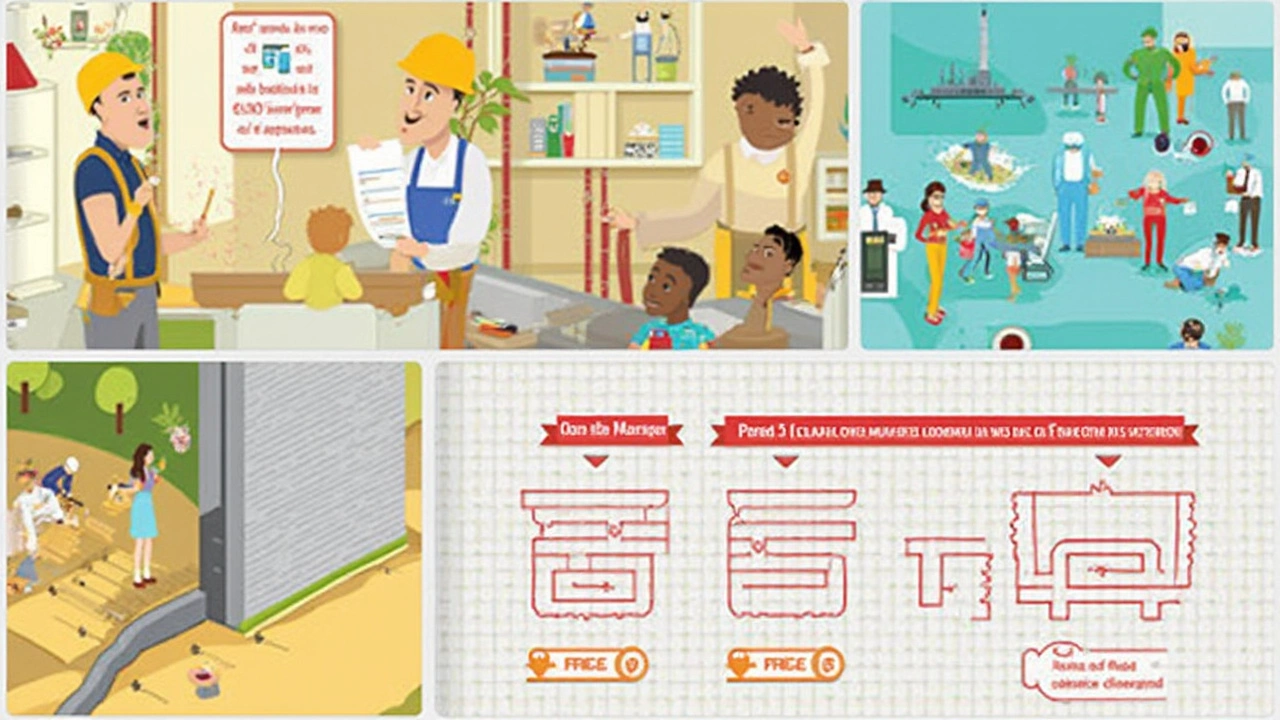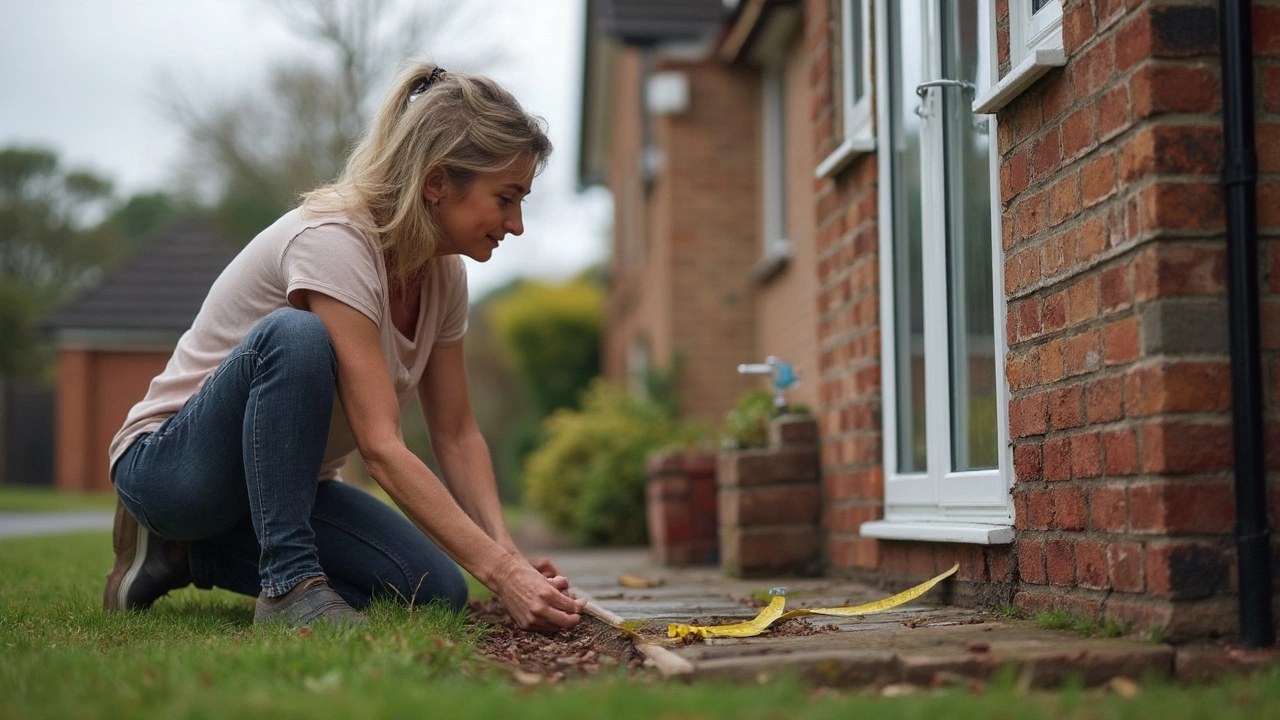So, you’ve spotted a horizontal crack in your foundation and your stomach drops. Is your house about to slide into the neighbor’s yard, or is this just another home headache you can put off? The price to repair a horizontal foundation crack isn’t pocket change, but it doesn’t have to empty out your savings either—unless you ignore it for too long.
Horizontal cracks tend to make homeowners nervous, and for good reason. Compared to vertical cracks, they usually mean your wall’s getting pushed in by soil. That adds pressure your home wasn’t built to handle. The kicker? Costs can swing wildly—think anywhere from $2,500 if caught early, to over $15,000 if you wait and things get worse. Why such a big range? It all comes down to what’s causing the crack, how deep the damage runs, and what fix is needed.
If you’re looking for ways to keep the bill lower, you’re not alone. I’ll break down what factors crank up (or down) the price, when you need to bite the bullet and hire a pro, and what you can actually handle yourself. Stick around, and you’ll know exactly what to expect when you get that estimate.
- What Causes Horizontal Foundation Cracks?
- How Serious Is a Horizontal Crack?
- How Much Does Repair Really Cost?
- What Affects the Total Price?
- DIY vs. Hiring a Pro: Is It Worth It?
- Pro Tips to Avoid Future Cracks
What Causes Horizontal Foundation Cracks?
When you spot a horizontal crack running along your foundation wall, something serious is usually going on. These cracks aren’t just about old concrete. They’re a big red flag that pressure from outside is pushing in—way more pressure than the wall was built to handle. Let’s break down what causes this trouble.
- Hydrostatic Pressure: This one’s huge. When the soil around your home gets soaked with rain or melting snow, it swells up and shoves hard against your foundation. Over time, this relentless pressure makes the wall give in, causing horizontal cracks.
- Poor Drainage: If water isn’t directed away from your house by gutters or grading, it pools up next to the foundation, making the soil heavier and adding even more push against your wall.
- Expansive Clay Soils: Some soils—especially clay—suck up water, expand a lot, and then shrink when they dry out. This growing-shrinking cycle hammers your walls season after season.
- Poor Construction: If the wall wasn’t reinforced well during construction, it’s a sitting duck for cracks once the soil starts pushing inward.
- Frost Heave: In colder climates, frozen ground can push against your foundation when the ground warms and thaws out. That’s another big source of side-to-side pressure.
| Factor | How Much It Raises Risk |
|---|---|
| Improper drainage | Up to 3x higher chance of cracks |
| Expansive clay soils | Twice as likely to cause issues |
| No foundation reinforcement | Most common in homes built before 1980 |
| Heavy rainfall area | 40% more risk each rainy season |
Notice most of these issues don’t get better on their own. That’s why catching what’s behind your crack early can save you a ton of cash and headache. If you’re unsure about the real culprit, talk to a foundation crack repair pro and have your wall checked out. The longer you wait, the more expensive things get.
How Serious Is a Horizontal Crack?
Here’s the deal—horizontal foundation cracks are never something to wave off. If you see one, it’s like your house trying to get your attention before things get way worse. They usually mean pressure is building up from the outside, pushing your wall inward. Around 80% of horizontal cracks come from soil pressure or water build-up, especially after a big rain or a rough winter thaw.
The big red flag is that these cracks are way more urgent than vertical ones. Vertical cracks usually mean the concrete is settling or shrinking, but horizontal cracks often spell trouble with stability. According to the International Association of Certified Home Inspectors, or InterNACHI,
"Horizontal cracks are usually caused by pressure against the foundation wall from water-saturated soils or frost. These are considered more serious than vertical cracks and should be addressed immediately."
If you spot a horizontal crack that's wider than 1/4 inch or is actively getting bigger, that’s a sign the wall might even start to bow or buckle. Here’s what makes these cracks so risky:
- Foundation crack repair for horizontal cracks usually means stabilizing the whole wall, not just patching the surface.
- If ignored, you could end up with doors and windows sticking, new cracks in drywall upstairs, even basement walls caving in.
- Mold, mildew, and water leaks love to follow a neglected crack.
If you’re not sure whether your crack is really growing, snap a pic with your phone and check again in a month. If it’s wider, more jagged, or you see shifting, don’t wait. This is when it pays off to call in a structural engineer or a foundation pro to figure out how bad it is and what needs fixing. Fixing it early is almost always cheaper than cleaning up the mess later.
How Much Does Repair Really Cost?
Here’s what you actually care about: the numbers. Most folks pay between $2,500 and $8,000 to fix a typical horizontal foundation crack. That range covers most jobs where the wall isn’t bulging more than a couple of inches. If the wall is caving in or cracked along almost the whole length, it could jump to $10,000 or more.
The repair method has a big impact on the price. For simple cracks where the wall is basically stable, contractors might use epoxy or polyurethane injections. These run anywhere from $350 to $700 per crack, but that only makes sense if the structural risk is low—and for foundation crack repair, safety comes first. If the wall is bowing, your contractor may install steel or carbon fiber straps to hold things together. These cost about $400 to $700 per strap, and you’ll need one every 4 feet or so. A 24-foot wall could mean at least six straps, so you’re looking at $2,400 to $4,200.
Extreme cases can mean digging outside the foundation and rebuilding part of the wall, which often runs $15,000 and up—sometimes much more if your yard is cramped or you’ve got fancy landscaping in the way. None of these numbers include fixing drywall or repainting after the main repair.
If your home sits on a basement and you see a long horizontal crack near the middle or bottom of the wall, don’t put off getting an estimate. It’s not just about appearance—the longer you wait, the more you might pay down the road.
- Small crack injection: $350–$700
- Carbon fiber/steel straps: $400–$700 per strap
- Serious wall rebuilds: $10,000–$20,000+
Those prices might sting, but the cost of waiting can be way worse. Quick action almost always saves money.

What Affects the Total Price?
If you’re wondering why the estimate to fix your horizontal foundation crack swings so much, it all boils down to a handful of stubborn factors. Some are obvious, like how long the crack is, but others might catch you off guard. Here’s what actually moves the needle on what you’ll pay.
- Severity of the Damage: Wider cracks or ones with bulging walls cost more—simple as that. Small cracks cost less to fix, but if a wall is bowing or water is leaking through, brace yourself for a bigger bill.
- Repair Method: There’s a huge price gap between a quick epoxy injection and a full wall rebuild or anchor system. Simple crack injections can land under $2,500. If you need steel beams or carbon fiber straps, that number climbs. Anything that needs excavation—digging up soil—jumps straight to the expensive end.
- Accessibility: If your basement is finished or packed, or there’s fancy landscaping, getting to the crack can take more time and money. Stuck behind water heaters or heavy shelving? Labor costs go up.
- Foundation Material: Poured concrete, block, or stone—each one changes the fix. Block walls with horizontal cracks, for example, often mean you need extra reinforcement like steel I-beams or carbon fiber straps.
- Local Labor Rates: Prices in big cities like Chicago or San Francisco are way higher than small towns. Some states also have stricter building codes, which stack on more costs.
- Permits and Inspections: Some places require city permits and follow-up inspections for foundation work. Those fees add up.
Check out this quick comparison so you can see how each decision or issue can move the bill up or down:
| Factor | Low End Cost | High End Cost |
|---|---|---|
| Epoxy Injection (per crack) | $350 | $1,000 |
| Carbon Fiber Reinforcement | $800 | $3,000 |
| Steel I-Beam Installation (per beam) | $1,000 | $2,500 |
| Wall Replacement (full section) | $10,000 | $20,000+ |
| Permit Fees | $100 | $900 |
At the end of the day, the combination of repair method, severity, and your location is what really determines the bottom line on foundation crack repair. Anything that requires more hands, more tools, or more time means you’re definitely paying more. If you want to keep costs down, fix problems early before they turn into monsters.
DIY vs. Hiring a Pro: Is It Worth It?
Before you grab that tube of epoxy from the hardware store, let’s get real. Not every horizontal crack is a DIY job—even if videos make it look easy. Sure, some thin hairline cracks can be sealed by a motivated homeowner. But when it comes to true horizontal cracks, experts agree these aren’t just cosmetic. They’re often a sign your foundation is under real stress.
If cost is your main worry, here’s how things shake out:
| Repair Method | Typical Cost Range | Skill Level | Risk Level |
|---|---|---|---|
| DIY Crack Filler (epoxy/urethane) | $50 - $200 | Novice-Intermediate | High (if structural issue missed) |
| DIY Reinforcement Kits | $200 - $600 | Intermediate-Advanced | Medium-High |
| Professional Structural Repair | $2,500 - $15,000+ | Expert | Low |
Thinking about DIY? Ask yourself these questions:
- Does the crack run more than a few feet or get wider over time?
- Does the wall bow inward, even a little?
- Is water leaking through, or can you see daylight?
- Has a foundation crack repair pro suggested structural fixes?
If you answer yes to any of those, don’t mess around—call a pro. There’s no shame in hiring help. The stakes are big: botched repairs can lead to foundation collapse, flooding, or even a failed home sale down the road.
A pro brings more than just experience. They have the tools to spot the real cause, whether it’s hydrostatic pressure or shifting soil, and can recommend solutions like wall anchors or carbon fiber straps. Good companies usually back their work with a warranty—something you don’t get with a YouTube tutorial.
If the crack is tiny and purely cosmetic, you might save some money and patch it yourself. But when in doubt, get an inspection first. Spending $200-$400 for a pro’s opinion can keep you from gambling with the biggest investment you own.
Pro Tips to Avoid Future Cracks
If you want to stay ahead of foundation headaches, paying attention to a few simple things can save you thousands later. Most horizontal foundation cracks start because of pressure from outside—the soil gets wet, swells, or shifts, then pushes on your wall. Stopping that early makes a huge difference.
Here’s how to keep that pressure off your house:
- Foundation crack repair starts outside: Keep gutters clear and make sure downspouts send water at least 5 feet away from your foundation. Pooling water is a top reason for cracking.
- Slope soil around your house so rainwater naturally runs away from your foundation. A good rule: about 6 inches of drop for every 10 feet out from the wall.
- Fix leaky plumbing or irrigation systems right away. Slow leaks in basements or crawlspaces quietly wreck your foundation over time.
- Use mulch sparingly and keep flowerbeds edged where they don’t collect water right up against your wall.
- If you see early signs of bulging, sticking doors, or cracking drywall above the basement—call for an inspection now, before it’s a crisis.
Wondering how often these issues cause trouble? Check out the table below for the most common sources of foundation cracks, based on a 2023 survey of U.S. home inspections.
| Cause | % of Cases Reported |
|---|---|
| Poor drainage near foundation | 42% |
| Expansive or shifting soil | 31% |
| Plumbing leaks | 17% |
| Poor construction practices | 10% |
Last thing—don’t put off repairs hoping cracks will just stop on their own. Most get worse if ignored, and the fix gets more expensive. Spend a weekend each spring checking for weird gaps or places where water’s pooling. That’s the easiest prevention you can do for your house.





